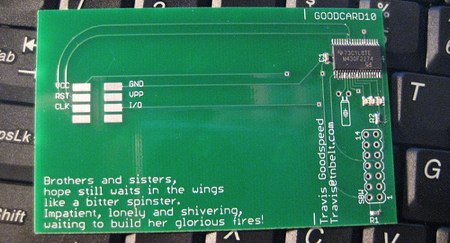Here’s a quick prototype from [Travis Goodspeed]. It’s a smart card built around an MSP430 microcontroller. We’ve used the MSP430 in the past because of its low power demands. He says this business card currently supports 1.8V to 3.3V, but a future design will have 5V as well. Technologies like Java Card exist for running applets on smart cards, but a familiar microcontroller like the MSP430 could certainly make development much faster. Knowing [Travis], there’s a reader somewhere about to go through some serious fuzzing.
Day: March 3, 2009
Distributed Computing In JavaScript

We’ve heard about the idea of using browsers as distributed computing nodes for a couple years now. It’s only recently, with the race towards faster JavaScript engines in browsers like Chrome that this idea seems useful. [Antimatter15] did a proof of concept JavaScript implementation for reversing hashes. Plura Processing uses a Java applet to do distributed processing. Today, [Ilya Grigorik] posted an example using MapReduce in JavaScript. Google’s MapReduce is designed to support large dataset processing across computing clusters. It’s well suited for situations where computing nodes could go offline randomly (i.e. a browser navigates away from your site). He included a JavaScript snippet and a job server in Ruby. It will be interesting to see if someone comes up with a good use for this; you still need to convince people to keep your page open in the browser though. We’re just saying: try to act surprised when you realize Hack a Day is inexplicably making your processor spike…
[via Slashdot]
Putting A Digital Picture Frame To Work

[Tobe] shares living accomodations with a few other people, so he built this tool to help them all communicate. using a Samsung SPF-83v wifi enabled picture frame, he’s made a central location for things like shopping lists and messages. He uses PHP for the database accessing and writes it all to an image using gd. Every 15 minutes a cron job runs that pushes the updated image to the picture frame.
Remote Thermometer Using Arduino

[Peter] sent in this writeup on how to build a remotely accessible thermometer. The hardware side is pretty easy on this one, all you need is an Arduino, a resistor and an thermistor. The software is where the main focus is. You can check the temperature via command line, but also via email. It can also tell you the temperature using the host computers sound hardware. You can see a video of it in action after the break. We have to wonder why he didn’t make it twitter.












